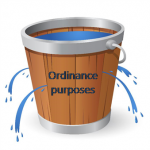Variances
 A variance allows a property to be used in a manner forbidden by the zoning ordinance. If the purposes of a zoning ordinance are held in a bucket, and variances (leaks) are granted that compromise ordinance purposes, then over time the purposes of the ordinance are lost.
A variance allows a property to be used in a manner forbidden by the zoning ordinance. If the purposes of a zoning ordinance are held in a bucket, and variances (leaks) are granted that compromise ordinance purposes, then over time the purposes of the ordinance are lost.
The video, Role of the Zoning Board, can help you understand the importance in understanding why zoning board decisions such as variances matter..
Types of Variances
Two types of zoning variances are recognized in Wisconsin:
- Area variances provide an increment of relief (normally small) from a physical dimensional restriction such as a building height or setback.
- Use variances permit a landowner to put a property to an otherwise prohibited use. Use variances are prohibited in shoreland zoning. See page 102 in the Zoning Board Handbook for reasons that use variances are not advisable in any type of zoning.
For people with disabilities who may need a ramp or other accommodations that do not comply with ordinance provisions, we recommend using a staff-issued administrative permit or waiver as described in Accomodations for the Disabled, rather than the variance process.
What are the standards for granting a variance?
To qualify for a variance, an applicant has the burden of proof to demonstrate that they meet all three variance standards:
- Unnecessary hardship
- Due to conditions unique to the property
- No harm to public interests
For floodplain variances, the applicant must show they meet an additional 13 standards.
Variance Standard Meanings
The variance standard meanings are defined by many court decisions. Below is a brief and incomplete introduction to what each variance standard means for area variances.
Unnecessary hardship
Unnecessary hardship is present when compliance with the ordinance would do one of two things:
- unreasonably prevent the owner from using the property for a permitted purpose. For example, if a lot is zoned residential, would complying with the ordinance prevent the lot from being used for a home. If a property owner is already living in a home on the lot, then they’re not prevented from using the property for residential use. (Ziervogel v. Washington County Board of Adjustment, 2004)
or
- be unnecessarily burdensome in view of ordinance purposes
In one case, the Wisconsin Supreme Court was asked if an after-the-fact variance should be granted for a porch built without a permit partially in a setback. The court responded that the variance should not be granted because the “hardship was self-created and the porch no more than a personal convenience”. The owner claimed that not being allowed to build the porch would be an unnecessary hardship for five reasons. Review the short video, Variances, to learn how the court responded to this list of reasons.
The Supreme Court went on to say: “Growth of a family and personal inconvenience do not constitute practical difficulties or unnecessary hardship which justify a variance. It is not the uniqueness of the plight of the owner, but uniqueness of the land which is the criterion”. (Snyder v. Waukesha County Zoning Board, 1976)
Conditions unique to the property
Conditions unique to the property such as steep slopes or wetlands must prevent compliance with the ordinance. If an alternative location exists on the property that would not require a variance, this standard is not met. Not every small or steep property meets this standard.
No harm to the public interests
A variance granted may not harm public interests. “Public interests” are the purpose and intent of the ordinance that were adopted by the elected officials representing the community.
IMPORTANT: Before making a variance decision, zoning board members should review the Role of the Zoning Board and Variances videos. The Variance Chapter from the Zoning Board Handbook provides additional important information. Zoning boards may only grant a variance if the applicant provides evidence that they meet all of the standards in this Variance General Zoning Decision Form.
Watch: Variances
An explanation of variances and the legal standards zoning boards follow to decide whether to grant a variance.




